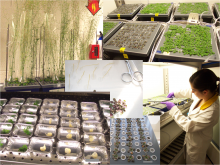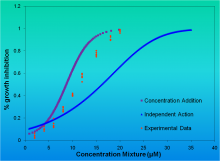The STAR project finished on 31st July 2015 - page no longer being updated
Key Question: Are radiation protection criteria protective enough when considering a mixed contaminant context ?
Background
Contaminants never occur in isolation. Increasing industrialisation and population density have led to situations where humans and the environment are exposed to a multitude of potential stressors. Often little is known about the mid- and long-term health and ecological consequences of these especially when they occur as mixtures. The consideration of chronic low-level mixed exposures presents considerable challenges for methodology and data interpretation.
Increasing data are becoming available which suggest that the effects of chemicals when present in mixture cannot be predicted simply from their effects when present as a single contaminant. However, it is impossible to experimentally assess the effects of all possible mixtures for all species and exposure conditions. We therefore need tools to make extrapolations and to help understand and predict mixture effects.
Determining mixture effects is complex as the contaminants may interact at different levels. Co-contaminants may affect the mobility, absorption, distribution, storage, biotransformation, elimination and evolution of toxic effects of other contaminates. To fully understand the effects of multiple stressors on life-history responses such as growth, reproduction and survival requires challenging experimentation and a multidisciplinary approach.
Can mixture effects be predicted from single contaminant effects? |
Radiation and mixed contaminant exposure situations
Radionuclides never occur in isolation. Radiation exposure conditions entail a number of radionuclides which are treated in impact and risk assessments in an additive way although considering different weighing factors for different radiation types. This additivity has never been questioned. However, most if not all, radiological exposure situations (e.g. uranium mining and milling, releases from nuclear power plants) are essentially mixed contaminant exposure situations with a mix of radionuclides, heavy metals, metalloids or organic pollutants.
Recently, benchmark dose rates for use in environmental radiological protection assessments have been derived from studies during which chronic gamma irradiation was the only stressor (see Ecologically Relevant Low Dose Effects). Exposure to radiation in the presence of other contaminants may mean that the derived dose rate benchmarks are not protective.
Progress and developments in ecotoxicology
Over the past few years the effects of mixtures have received increased attention including EC projects (including MIXTOX, NoMiracle, BEAM, ACE, EDEN and CONTAMED). Such studies have considered the use of multimedia-fate models, biotic ligand models and toxiciokinetic models to assess the influence of mixed contaminants on availability. Developments have included: descriptive and more process based models to assess effects of mixtures and; novel methods to improve the risk assessment of chemical mixtures. However, these initiatives did not include ionising radiation amongst the stressors they considered. We will build upon the outcomes of these ecotoxicological projects and critically evaluate and test methods of assessing multicontaminants specifically including ionising radiation as one of the stressors.
The overarching objective of this Workpackage is to understand the mechanisms and processes by which mixtures of contaminants interact to induce adverse effects on biota and the environment in order to determine if radiation protection criteria are protective enough when considering a mixed contaminant context which will be achieved by addressing three specific objectives which aim to:
- Review methods and tools developed in ecotoxicology for assessing mixed contaminant exposures, and evaluate their applicability to radioecological research and assessments.
- Test and improve selected ecotoxicological method for radionuclide bioavailability and exposure assessment under mixed contaminant conditions.
- Apply approaches developed in ecotoxicology to assess the effects of mixed contaminant conditions.
 |
Outputs
- Review of methods in ecotoxicology for mixed exposure (see Deliverable 4.1 below)
- Tools for assessing availability and exposure in a multiple contaminant context
- Tools for mechanistic understanding of induced effects for mixed exposure
- A critical evaluation of how mixed contaminant conditions may affect radiation protection standards and provide a roadmap for future multiple contaminant research
Achievements so far
- Development of a Uranium Biotic Ligand Model for aquatic organisms under mixed contaminant conditions:
- Test organisms: Lemna minor, Daphnia magna and Atlantic salmon (Salmo salar).
- Binary mixture exposure experiments applying classical ecotoxicological settings and CA/IA as reference models
- Exposure conditions: External gamma irradiation + Cd; External gamma irradiation + fluoranthene; U(VI) + Cd; U(VI) + fluoranthene.
- Test organisms were selected from different species groups and levels of biological organisation which is expected to aid in the extrapolation process:Invertebrate: C. elegans; Plant: L. minor; Vertebrate: Fish: S. salar; Community: Plankton
- Binary mixture exposure experiments applying the DEBtox approach
- Exposure conditions: External gamma irradiation + Cd
- Test organisms: C. elegans; L. minor
- Application of a number of Cumulative Risk Assessment methodologies to situations where radiation is among the mix
The photographs below show our test organisms: Daphnia magna, Lemna minor, Salmo salar, Caenorhabditis elegans, Plankton community
Publications:
Overview of existing approaches, methods and tools developed in ecotoxicology for assessing exposures, effects and risks in a mixed contaminant context. See here for the summary.
Vanhoudt N., Vandenhove H., Real A. Bradshaw C., Stark K. 2012. A review of multiple stressor studies that include ionising radiation. Environmental Pollution, 168, 177-192.
Useful links:
NoMIRACLE: Novel methods for integrated risk assessment of cumulative stressors in Europe
BEAM: Bridging effects assessment of mixtures to ecosystem situations and regulation
MIXTOX: Conceptualizing the effect assessment of toxicant mixtures to soil organisms
ACE: Analysing combination effects of mixtures of estrogenic chemicals in marine and freshwater
EDEN: Low-dose- and mixture-effects of endocrine active chemicals and their mode of action
CONTAMED: Contaminant mixtures and human reproductive health – novel strategies for health impact and risk assessment of endocrine disrupters.
International Union of Radioecology’s Task group on the Ecosystem Approach to Environment Protection
International Atomic Energy Agency’s Coordination Group on Radiation Protection of the Environment
International Atomic Energy Agency’s EMRAS II Working Group on Biota Effects
Under the IAEA-EMRAS II programme, the Biota-Effects Multiple Stressor Working Group performed a review was performed to determine the state of research in the area of multiple stressors and to assess if such review might permit a gross generalization as to whether the combined effects of multi-stressors and radiation are fundamentally additive, synergistic or antagonistic. See the paper of Vanhoudt et al. above for more information.
This workpackage is co-ordinated by Hildegarde Vandenhove of SCK•CEN.

